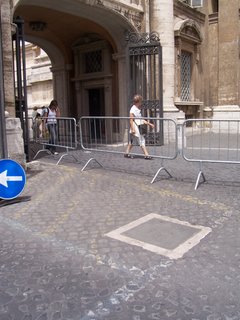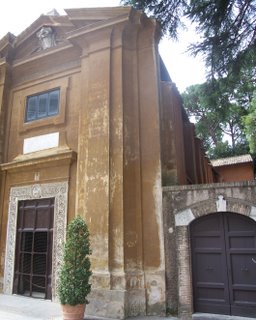Behind Saint Peter's
Today for my Michelangelo class we had special permission to go to the south end of St. Peter's, the only part of the exterior to be finished during Michelangelo's lifetime. Additionally, since it was finished, all of the other architects had to follow his design the rest of the way around. However, we started at Santa Maria degli Angeli e dei Martiri, and then stopped on the Campidoglio before going to the Vatican. Alas, I will begin with that which is behind St. Peter's, that is, past the Swiss Guards where you usually can't go without a good reason.
 This is the door to the Ufficio Scavi, for going to the fascinating excavations under St. Peter's, but the square in the pavement in the foreground of the picture marks the place where the obelisk used to stand before it was moved to the middle of the piazza in 1586. It used to be the spina, or center, of the Circus of Nero. It's of interest since it really isn't otherwise marked.
This is the door to the Ufficio Scavi, for going to the fascinating excavations under St. Peter's, but the square in the pavement in the foreground of the picture marks the place where the obelisk used to stand before it was moved to the middle of the piazza in 1586. It used to be the spina, or center, of the Circus of Nero. It's of interest since it really isn't otherwise marked.
 Here's the dome of St. Peter's from the back, which is effectively how it would look from the front if the church hadn't been made into a basilica plan and had stayed in the Greek cross shape favored by Bramante and Michelangelo. A Greek cross (four equal sides) would have made St. Peter's into a symbolically new Hagia Sofia, for the new Constantinople, Rome.
Here's the dome of St. Peter's from the back, which is effectively how it would look from the front if the church hadn't been made into a basilica plan and had stayed in the Greek cross shape favored by Bramante and Michelangelo. A Greek cross (four equal sides) would have made St. Peter's into a symbolically new Hagia Sofia, for the new Constantinople, Rome.
Additionally, since the drum was completed by Michelangelo's death, they had to build the dome with the measurements he had made... Interesting, the amount of constraint Michelangelo put on the building posthumously.
 Here's the south side which was definitely done before Michelangelo died and that constrained future architects -- mainly Giacomo della Porta, to continue on with more of the same.
Here's the south side which was definitely done before Michelangelo died and that constrained future architects -- mainly Giacomo della Porta, to continue on with more of the same.
 Finally, this little church is St. Stephan Martyr of the Abyssianians. I think this might be a space where, behind the doors on the right, there is a Byzantine chapel, but I could be wrong. Obviously, it is not usually open, and it is a very ancient church. My photo of the interior did not come out well, unfortunately.
Finally, this little church is St. Stephan Martyr of the Abyssianians. I think this might be a space where, behind the doors on the right, there is a Byzantine chapel, but I could be wrong. Obviously, it is not usually open, and it is a very ancient church. My photo of the interior did not come out well, unfortunately.
 This is the door to the Ufficio Scavi, for going to the fascinating excavations under St. Peter's, but the square in the pavement in the foreground of the picture marks the place where the obelisk used to stand before it was moved to the middle of the piazza in 1586. It used to be the spina, or center, of the Circus of Nero. It's of interest since it really isn't otherwise marked.
This is the door to the Ufficio Scavi, for going to the fascinating excavations under St. Peter's, but the square in the pavement in the foreground of the picture marks the place where the obelisk used to stand before it was moved to the middle of the piazza in 1586. It used to be the spina, or center, of the Circus of Nero. It's of interest since it really isn't otherwise marked. Here's the dome of St. Peter's from the back, which is effectively how it would look from the front if the church hadn't been made into a basilica plan and had stayed in the Greek cross shape favored by Bramante and Michelangelo. A Greek cross (four equal sides) would have made St. Peter's into a symbolically new Hagia Sofia, for the new Constantinople, Rome.
Here's the dome of St. Peter's from the back, which is effectively how it would look from the front if the church hadn't been made into a basilica plan and had stayed in the Greek cross shape favored by Bramante and Michelangelo. A Greek cross (four equal sides) would have made St. Peter's into a symbolically new Hagia Sofia, for the new Constantinople, Rome.Additionally, since the drum was completed by Michelangelo's death, they had to build the dome with the measurements he had made... Interesting, the amount of constraint Michelangelo put on the building posthumously.
 Here's the south side which was definitely done before Michelangelo died and that constrained future architects -- mainly Giacomo della Porta, to continue on with more of the same.
Here's the south side which was definitely done before Michelangelo died and that constrained future architects -- mainly Giacomo della Porta, to continue on with more of the same. Finally, this little church is St. Stephan Martyr of the Abyssianians. I think this might be a space where, behind the doors on the right, there is a Byzantine chapel, but I could be wrong. Obviously, it is not usually open, and it is a very ancient church. My photo of the interior did not come out well, unfortunately.
Finally, this little church is St. Stephan Martyr of the Abyssianians. I think this might be a space where, behind the doors on the right, there is a Byzantine chapel, but I could be wrong. Obviously, it is not usually open, and it is a very ancient church. My photo of the interior did not come out well, unfortunately.




0 Comments:
Posta un commento
<< Home